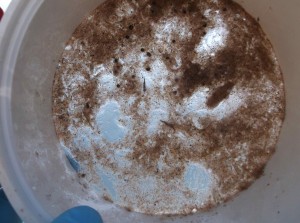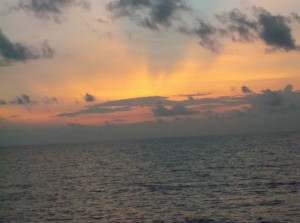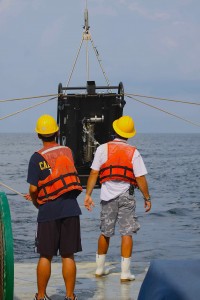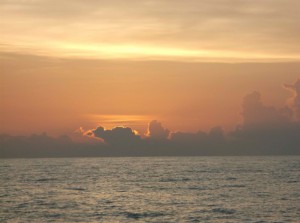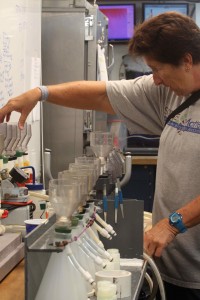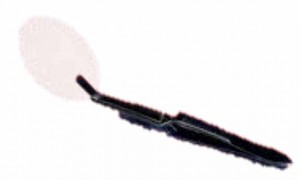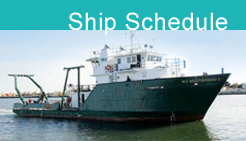Deep Sea Fish and Sediment Surveys in the Gulf
Oceanic Updates

Saturday pm
Aug 15th
Posted by K.Bylsma, C-IMAGE , Teacher at Sea on Saturday , August 12 pm-
What an incredible day of learning. After I worked on the Bongo nets a couple of times collecting, analyzing and preserving biomass with Kat Ternus, I returned to the filtering lab. What many outsiders consider a very dull group of people ( scientists) were far from dull. This evening was a our second site of the day as we are ahead of the outlined schedule—flexible, remember. Joe as running the nitrogen tests, while Sue was running her favorite chlorophyll tests. I was left with the urea and “extraordinary” pigment tests I told you about before. We were truly a well oiled machine, truly enjoying the task at hand and each other’s company. So, today, we completed PCB03, and PCB02. What a day!
Several things I did notice in the transition times, though. I saw 2 cabin cruisers and a house fly and a dragonfly. Why is that important when we’re out in the Gulf?
I have several additional questions, though, for students:
*How do you explain the cloud patterns over the water as compared to the cloud patterns at your house/school?
* What is a whale shark and why would they be found in the Gulf?
* What types of dolphins are found in the Gulf? I saw several again today.
Teachers:
Now that we have collected all of these samples and some data, these and MANY other scientists will take them to their labs and compile the data. What I have heard from these scientists over and over again is that they and their colleagues have collected VOLUMES of data ( the SIPPER has terrabytes of images to be identified), but there are not enough scientists to do the work in a timely manner. One of the fields that I heard repeatedly mentioned as lacking personnel was taxonomy. We’re not training enough people to painstakingly identify species, whether by images from the SIPPER, samples from the SHIPEK or water samples from each of TWELVE stations this trip alone.
Joe , an undergraduate student at USF is here because he is studying Environmental Policy and is taking his girlfriend’s place this cruise ( pictured above with the Bongo nets). We’ve been working together off and on this week. Ironically, he went to high school in this area and like many high school students he had trouble finding his passion in the classroom. His district opened an Environmental center and he was hooked ! He states that his entire outlook on learning changed. Prior to this time, there was no active involvement in his learning , no hands on/ minds on exchange. He states that “ the lightbulb went off”. What greater reward is there than knowing that you made a difference in someone’s life? His teachers certainly have made a difference.
When I heard this from Joe, it reminded me that each child we see this year and every year is a “ Joe” searching for his niche. We, as teachers are the wayfarers nudging and encouraging them at stages in that venture.
It’s now 2200 and the group is enjoying each other’s company in the galley with an old movie that they’ve each already seen.
Looks as if tomorrow is PCB01 starting at 0800 and possibly into Panama City around noon.

On Dry land
Aug 15th
Posted by K.Bylsma ,C-Image Teacher at Sea for Monday, August 11 0500.
The routine has been WHENEVER you get up, it’s time to work, so here I am. From Bayboro Harbor in St. Petersburg throughout the Gulf at 12 stations; collecting CTD samples 21 different times ;Shipek sampling soils at 10 locations; Bongo nets collecting biomass at 12 locations; and either the SHIPPER 3 or the SHIPPER 4 collecting images at 13 different times ( for often 5 hours at a time), it’s time to analyze the data.
What have we learned?
· ****we each have a role in protecting our environment
· ****all systems have a delicate balance to maintain and are impacted by their surroundings
· *****research requires an enormous amount of time and expertise which invariably leads to more questions than answers
· ****while the Gulf creates Florida’s weather patterns, providing us with innumerable resources, our anthropogenic footprint is already visible. We have to decide how indelible that footprint will be.
*****How will the chemical, biological, geological data guide our decisions? ( I’m certainly hoping that we take the data seriously and make sound decisions based on that data because ….. that’s science !

Sunday wrap up
Aug 15th
Posted by K. Bylsma , C-IMAGE , Teacher at Sea for Sunday, August 10,2013.
Today was the last day of testing at site PCB01. WOW!! Drop was at 8:00, so in our perfected system, we were finished in NO time.
Jonelle spent this time teaching me how her toxicity tests work from the Shipek samples. This is quite a process, given that only a small fraction of her testing takes place while we are still on the boat. She then takes the samples to the lab, grows E-coli bacteria , dilutes the samples, incubates, dilutes, and regrows for 120 agar laden petri dishes. The process usually takes about 3 weeks. She drew out a schematic of the process for me to better understand , as well as the immediate data collected on the Microtox machine. (see photo) The only toxicity levels that were positive on the samples she shared were the surface of two stations, one of which was the surface layers of DWH.
Her Master’s work in microbiology has prepared her for extensive lab work, leadership on these cruises, and an opportunity to share with her native Trinidad community. ( She has worked on oil rigs in Trinidad and returns periodically to
After that, it was time to clean and pack. This group has a real system down, a kind of bucket brigade where everyone takes a job or a section to be responsible for. Everyone pitches in as we are cruising into port in Panama City. By noon, we have docked and most everything is secured. Thomas made lunches early so that everyone can finish their sections.
We remain on the vessel tonight and drive back in rental vehicles tomorrow to St. Petersburg. This has been one of the most rewarding learning experiences ever offered. I have several wishes, though;
* That more educators were extended these types of professional growth opportunities.
* that students will be able to experience through this blog a portion of the excitement, joint learning with specialists, and an appreciation for the interconnectedness of systems.
* that ( teachers) YOUR school year is as exciting and rewarding as this has been for me !

Later on Friday
Aug 15th
Friday, part II posted by K.Bylsma, Teacher at Sea for C-IMAGE
The schedule has been revised again. We’re towing SIPPER III again, because Sipper IV is not operational ( water in the CPU, I think I overheard- robotics, keep this in mind when building).
Anyway, this am’s second set of tests were interrupted by breakfast ( remember, meal time is not amendable, says Thomas). Sue finished up the tests. Next thing I know, we’re bracing for the turbulence all day ( both sides of the DeSoto Canyon). PCB05 will be shallow compared to what we’re been sampling. What does that imply about the water chemistry or the quantity or diversity of the biomass ? That’s what the samples will tell us. All of this data has been collected on roughly 18 of these trips over the past 3 years , following the Deep Water Horizon.
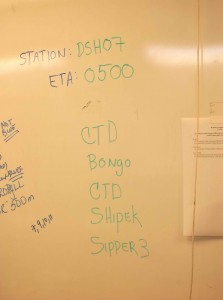 ETA is 2300, yes, that’s 11:30 tonight, again. You run the tests when you have the materials- RULE. ( This photo is an example of the task sequence at listed on the job board at each sampling site- not just this site)
ETA is 2300, yes, that’s 11:30 tonight, again. You run the tests when you have the materials- RULE. ( This photo is an example of the task sequence at listed on the job board at each sampling site- not just this site)
Had a discussion with Karl, the USGS representative who is studying ocean acidification. His samples are taken from the surface waters as the vessel continues to voyage. The instrumentation that he is using collects salinity, pH, temperature, O2, CO2, nitrogen, phosphorous. During my discussion with USGS, I asked about karst topography that is so specific to Central Florida. According to NGSSS, seventh grade is when our students learn about geology- tectonic plates, geologic time, and hopefully a bio/geo/chemical relationship. I am grateful that his expertise matched what I had researched for our kids. The erosion caused by acidifications in the limestone causes the collapses in the water table resulting in sinkholes. I had no idea that much of this karst region stretches from Alachua to Lee counties!! From this topic, we pursued phosphate mining in our region that results in some homes and businesses being built on the conversion of phosphate slag into radon —— a radioactive element. More on this chemical exchange later . Buyer beware. We also included the environmental hazards of wetlands construction (or restructuring) because of the similar chemical conversions.
Finally, and related to the DWH event… what happens to real estate where a gas station once was located? Not to be paranoid, but gas lines leak into the layers of soil/ bedrock/ etc and become trapped. How long does it take to completely remove carbon based fuels from organic matter ? Is it ever truly gone? Not according to the Law of Conservation of Matter.
What does all this have to do with the DWH event or the data being collected? It’s the study of human impact on the environment and the critical balance that has to be maintained.
Check these out –
http://sofia.usgs.gov/publications/maps/florida_geology/
http://water.usgs.gov/ogw/karst/kigconference/abt_karstfeatures.htm
http://fipr1.state.fl.us/PhosphatePrimer/0/C8D7947AB36A400E85256F880077B8CA

Friday’s adventures
Aug 15th
AHOY ! It’s officially Friday, August 9. 3:45 came REALLY early after we didn’t clean up the lab from last night’s filtering until 2300. The CTD drop time was scheduled for 0400.Now that I’m up with coffee in hand, the deployment has been postponed until 0500 according to the job board in the lab ( something must have happened to the sipper during its 5 hour deployment )
I have noticed that by day 4 ( even though the first day is strictly getting to our test site) people had already lost track of the date, let alone the day of the week. We take so much for granted! Today is cruise day 5, though. Another thing about the time, we had crossed into the central time zone and everyone was having trouble remembering the sunrise/sunset time for their specific plankton tests ( central time zone is an hour sooner than our time in Wesley Chapel). If your smart phone had “synced” automatically, then all is well, otherwise, it’s very confusing.
We hit rough water, comparatively. The boat has rocked most of the night, so that one of my berthmates has been sick off and on throughout. The captain had relayed early in the day that this was to be expected and that the turbulence ( water, not air) had been very little for August – when we get so many storms, let alone hurricanes. ( I’m told that these are ONLY 3-4 feet seas, but it feels more like Zumba at Adventure Island.)
Anyway, we rotated to new stations yesterday and my new station ( for two drops) was testing for HPLs( high performance – a chromatography of special pigments – orange, yellow, etc.) , PPs ( phosphate particulates) , and nitrates.
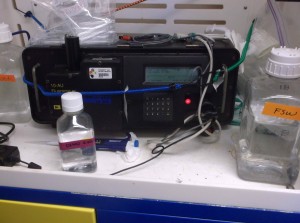 As Sue explained to us, though, we may have high levels of nitrates from the humectant – decaying matter, maybe leaves, but the chlorophyll levels are what tell us if the certain plankton are respiring ( CO2) or not. How do you explain that there are enough nutrients in the water, to support the plankton community, but they don’t seem to have populated the waters as expected? Joe took over my spot with the nitrate tests and Sue is still plugging away with her chlorophyll tests- her particular favorite. The waters where we have been testing are considered oligotrophic since there are limited plankton species. ( We learned about these species in our class and marine biology references reminded me what I was looking for).
As Sue explained to us, though, we may have high levels of nitrates from the humectant – decaying matter, maybe leaves, but the chlorophyll levels are what tell us if the certain plankton are respiring ( CO2) or not. How do you explain that there are enough nutrients in the water, to support the plankton community, but they don’t seem to have populated the waters as expected? Joe took over my spot with the nitrate tests and Sue is still plugging away with her chlorophyll tests- her particular favorite. The waters where we have been testing are considered oligotrophic since there are limited plankton species. ( We learned about these species in our class and marine biology references reminded me what I was looking for).
Teachers: This is my chance to plug the Outreach classes from USF. Dr. Greely offers NOAA/ BWET/ GLOBE classes to teachers.. We’ve had teachers from all over the state participate in these classes, usually on Saturdays and often times involving a field trip or two. Getting the word out is how we share in learning. Contact Dr. Greely at USF’s Marine Institute. When I see her name or Angela Lodge on my email, I respond immediately. You don’t want to miss out on their instruction because there is application regardless of your grade level or specific content area and they share resources and tools that are incredibly practical.
…. Gotta run. Time to deploy the CTD , then bongos, followed by the Shipek ( new tool for this venture), and then the SIPPER again. We’re in more shallow waters, so the run is shorter, but what would you expect to see for chemistry ( more or less nitrates and phosphates) and plankton ( more or less biomass ) in the Bongo nets?

Saturday am
Aug 15th
Posted by K.Bylsma, C-IMAGE , Teacher at Sea on Saturday am.
Last night’s water filtering was completed at 0200 – which is actually Saturday! Today’s CTD drop, though was scheduled for 0800, so prep time had to be completed by 0700. No one was up, so I watched the sunrise while the dolphins played around the bow of the boat. Right after that, I was assigned a new task. A contact of Heather’s needed to collect rain water at designated latitudes, so I was handed a small jar to take to the bow of the vessel. Standing in the rain, I had to hold the container at a 45degree angle collecting rain water for about 30 minutes. The temperature was certainly satisfying and the natural shower was refreshing. This sampling will be continued at other latitudes.
Next, it was time to set up the tests for water samples and then launch the Bongo nets. Teachers: Lots of math this time around ( not that the measuring and chemistry components have not also had math)( See Heather’s calculations)
1 knot (kt) = 1.15077945 miles per hour (mph)
While on this trip, we have been changing our speed relative to whatever we’re towing at the time. Normal travel speed varies, but speed is 8 kts. Towing the bongo nets and the Shipek requires a speed of 1.5-2 kts , the CTD requires a 1.5-2 kts travel speed and the SIPPER requires a travel speed of 3 kts.
Teachers: Allow students to 1/ convert knots to miles per hour ( probably a more familiar term to them. 2/ Encourage discussion with the students involving the engine system in each of the towing incidences- without additional tow ( only passengers), towing the Bongo nets, towing the SHIPEK, and towing the SIPPER ( #3 was #250-300 , while #4 was #450.
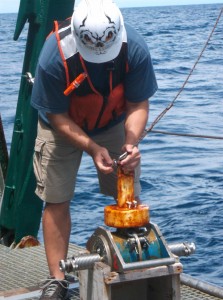 The Shipek is used to collect soil samples. I had wanted to witness this activity. Jonelle is collecting these samples to test for toxicity ( on the vessel) and followup testing for the next weeks in the lab, since these samples require baking them to remove the water. This will preserve the biological material for analyzation. The Shipek is different from coring samples due to depth. The Shipek is a “ trap” device that is activated when it hits the floor and then “scoops” a sample of earth into the trap. The winch then raises the SHIPEK back to the deck where the soils are released and tested for toxicity here on the vessel, but also back at the lab.
The Shipek is used to collect soil samples. I had wanted to witness this activity. Jonelle is collecting these samples to test for toxicity ( on the vessel) and followup testing for the next weeks in the lab, since these samples require baking them to remove the water. This will preserve the biological material for analyzation. The Shipek is different from coring samples due to depth. The Shipek is a “ trap” device that is activated when it hits the floor and then “scoops” a sample of earth into the trap. The winch then raises the SHIPEK back to the deck where the soils are released and tested for toxicity here on the vessel, but also back at the lab.



1- attached to a winch and closed, 2/ comes apart when the winch returns to deck, and finally, 3/ the sediment tray that is removed for testing.
More on the actual toxicity results later.

Last of Thursday 8/08/13
Aug 15th
Posted by K.Bylsma 8/08/13 pm
We were just interviewing Sue Murasko, the chemist from our C-IMAGE Weatherbird II cruise ( She is technically employed at another agency, Florida Wildlife Agency, but these cruises are her passion as well). Whenever we are filtering, she loves to run the chlorophyll tests . To her, these represent the true health of the aquatic plant life. While we filter the samples and catch types of chlorophyll onto the filters, she is actually using her lab tools to determine the types of algae that produce .
Sue routinely checked the monitoring device that USGS was using on their surface water samples ( remember that USGS is currently measuring the pH/ salinity of surface water to follow ocean acidification – Bo is tracking acidification throughout the layers of the Gulf)
After she checks for salinity and pH, then she matches that information to what she learns from her fluorometer while ”thinking out loud” about the data. Now that we’re three years out from the actual 2010 spill, what have we learned from “ this piece of the puzzle?” We know that near the DSH 09, there was more visible change to the waters, a pea-green discoloration, but according to the data, the chlorophyll count is not high, but the discrepancy seems to be with the types of algae blooming. We had just been discussing the “ big picture” and this chemistry piece leads to more questions, further studies.
Remember Kermit the Frog…. ” It’s great being green”- He had nothing on chlorophyll !!
Marine organisms ( This is a reference sheet for marine organisms that you might find helpful)

More Thursday adventures
Aug 15th
Posted by K. Bylsma C-IMAGE Teacher at Sea 8/08/13
The day started again at 0600. The SIPPER was finishing from last night’s late deployment ( we finished filtering water samples at 0100 !!)It’s quiet from a work standpoint, but Thomas is busy in the galley and the crew is gathering for breakfast. Jonelle is the only scientist up and ready at this point. We’re not deploying the CTD until 0800, so there’s some time to acclimate again. Sunrise is scattered clouds- more like summer weather. Several oil platforms still readily visible from this in transit location.
Gino ( engineer) called our attention to one of the rigs late last night that was “fired”, meaning that they had tapped their source from the rig and were burning the source- which answers the question , “ are the rigs operational?” Now, I’m wondering what fossil fuel source they actually tapped into and at what depth?
Questions, always questions.
All around me, there are relationships represented ( no, not those kind of relationships) , but the ones between 1/ organisms, 2/ systems ( mechanical, biological, etc.) , fields of study, etc. How do we measure these relationships ? ( Otherwise, how do I know that there is a relationship?)
Teachers:
1/ Start with organisms… ( examine this graphic that I located in my research)
This graphic organizer is , by no means comprehensive, but the questioning is a starting point – use it for identifying trophic levels, predator/ prey roles, etc. I like the energy flow, personally.
2/ From a systems approach, I have been analyzing and trouble shooting our water analysis system . Students could use our photos to do the same for the winch system, the bongo system, or other systems on the vessel.
3/ During this excursion, I’ve observed and participated in a number of interactions between the various represented fields of science. Again, students could be encouraged to use our photos and background research to create scenarios that describe these relationships, ie. an ecologist recognizes an issue in their data and creates a driving question. They present this issue to a colleague – chemist, biologist, etc. Since this pair of scientists now see common concerns ( from varying perspectives), they consult an engineer, who redesigns their data collection system to more accurately collect data to study this driving question. Just a thought. I found interesting career information at http://www.coolclassroom.org/home.html if that suits your needs. In the educational system ( pun intended), we tend to isolate the fields of study, rather than draw attention to their very necessary interrelationships.

Something is Afoot!: August 11, 2013
Aug 11th
Posted by E. McCormack, C-Image Teacher-at-Sea
Water, water everyday!
You might not think that you can tell a lot from a bottle of seawater, but the truth is that one of the most important missions on this cruise has been the collection of water samples. Bylsma and I have spent hours upon hours in the long lab, filtering water and preparing samples that will be run back on dry land for a variety of important measurement. In fact, from each niskin bottle of water collected, nine different measures will be collected and recorded. In this cruise alone, we have taken 143 different water samples across 12 stations at depths ranging from 2 to 2300 meters below the surface. Because scientists have systematically collected these samples over the past three years, we have begun to create a historical database that will allow us to develop a clearer picture of how the Gulf behaves over time.
All of these water samples we collected had to go through a complicated filter setup, and each was prepared following a specific protocol depending on what substances would be measured in the lab. We used a tiny 0.7μm filter, which is small enough to catch the tiny living phytoplankton, while all the dissolved nutrients pass through into the filtrate. One way to think of it is that all the biology gets stuck on the filter and the chemistry passes out in the filtrate! Keeping everything straight was a challenge, but I actually liked figuring out the most efficient way to get it done.
Things that make you go hmmm….
At first, as Sue Murasko, research scientist for Florida Fish & Wildlife and champion for phytoplankton water sampling in the Gulf, showed us the ropes, I’ll admit I was focused on learning the filtering process, and didn’t see much difference between any of the many bottles of water we poured through the filters. However, by the time we started the DSH deep water transect line, Sue got excited and even I noticed that we were getting some funky waters. Instead of the deep blue water we should have been seeing, the water had a greenish tinge (even though it was still mostly clear in the funnel). We noticed a slightly funky smell, and most importantly when you are filtering water in the middle of the night, it took FOREVER for the water to run through our filters! Something was weird out there, and we had a mystery on our hands!
Let’s examine the evidence.
1. The sea had a funny greenish tinge instead of its normal deep blue color.
2. We noticed a funky, fishy smell when we were filtering the water.
3. We should have been able to pour 4 L of water through the filters without a problem, but now the filters for the surface and near surface waters were completely clogged after half that amount and the water just sat there.
4. When we pulled the filters, which normally look clean to the naked eye, they had a brownish tinge.
As Sue said, something was definitely afoot! There had to be some unusual substance in this water big enough to clog the microfilters in the lab, but small enough to pass through the fine mesh we used when we pulled the water from the Niskin bottles.
Putting together the puzzle
At this point, Sue was getting excited and was looking for more pieces of the puzzle. The CTD device measures salinity on every cast, and Sue checks out the readings and finds out that instead of being in the 33-35 ppm range that we expect to find in near surface ocean water, we were looking at a salinity of 25 ppm. To see a change like this, either salt was being sucked out of the system (which doesn’t seem likely), or fresh water was being added.
Rainwater was the first thing that came to my mind sitting out there in the middle of the ocean so far away from any freshwater sources, but thinking it through, I realized it doesn’t work as an explanation. Rainwater can sometimes create a freshwater lens on the very surface of the water, but we were seeing our salinity change well below the surface. Also, we haven’t seen much more rain than scattered showers this past week. Even if it were pouring down, the Gulf is a huge reservoir of water, and to change salinity by 10 parts would require a huge input of freshwater—far more than normal rainstorms could produce.
So Sue asked me what other source of freshwater could we have so far away from land? What river could be big enough to have an effect out here??? Could it really be that the Mississippi is pushing water this far out into the Gulf?
A Working Hypothesis
The Mississippi Plume is where the water and sediments (about 500 million tons) carried by the Mississippi River enter the Gulf. From a satellite, you can see the area where the murky brown water of the river runs into the blue waters of the Gulf, but this usually happens much closer to shore than at the deep water stations that we were sampling. Sue felt that it might be the answer to our mystery, but as any good scientist knows ‘feelings’ aren’t enough to solve a mystery.
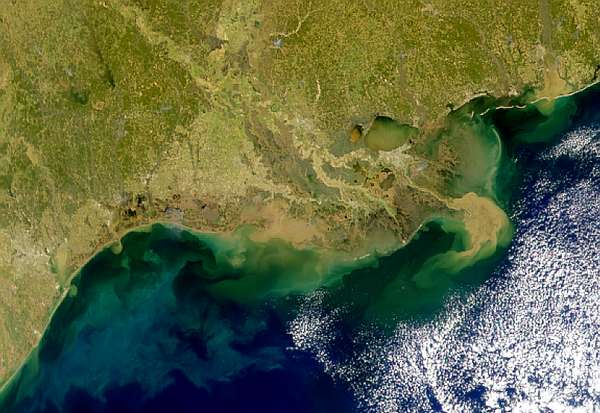
Notice where the brown waters of the Mississippi typically mix with the deep blue Gulf waters. The deep water stations we are sampling are usually beyond this region. Credit: Provided by the SeaWiFS Project, NASA/Goddard Space Flight Center, and ORBIMAGE
We were able to add a little more evidence in favor of our plume hypothesis when we started pulling in terrestrial detritus (aka twigs and sticks) from the bongo nets. Where would we be getting sticks from if they weren’t being carried out from land?? Checking in on the news, we found reports of heavy rains in the Midwest, and deadly flash floods in Missouri. All of this water had to feed into the Mississippi River, and eventually flood out into the Gulf.
More Measures Needed
Even though everything so far supports our plume explanation, we still don’t have enough information to accept our hypothesis. Sue will have to run our samples in the lab before we can be comfortable attributing our funky water to the Mississippi plume. We have all the samples we need to get the data to confirm our hypothesis, we just have to run these tests on land as we can’t do it as sea. One of the measures determines the amount of Chlorophyll A contained in the sample. Chlorophyll A is contained within the cells of photosynthetic organisms (out here, we call these guys phytoplankton), and is one of the pigments that allows these primary producers to convert energy from the sun into cellular energy. Measuring Chlorophyll A is a way to estimate how much phytoplankton we have in a system. If our hypothesis is valid, we would expect to see increases in amount chlorophyll from all of the freshwater phytoplankton that would have been swept along by the river.
Dissolved Nutrients
Several of the other measures that we sample for give us an idea of the amount of dissolve nutrients in the Gulf. One of the major goals of the C-Image project is to assess nutrients limitations for phytoplankton in the photic zone, or the part of the water column where light penetrates and photosynthesis occurs.

Jonelle Basso with the CTD. Jonelle's efficient and cheerful management of the water collection system made sure that everyone got their samples.
Phytoplankton require certain key nutrients to survive, and monitoring the concentrations of those nutrients in a system can give us an indication of the health of the system. Limiting nutrients are the essential nutrients that are most often used up in the system, and therefore act as a control on the number of organisms that can survive in that environment. For example, nitrogen in the environment is snapped up by the phytoplankton pretty quickly, meaning that we usually don’t detect much available nitrogen in a sample. Sometimes, however, a system might have an extra input of nitrogen from somewhere, and the limiting nutrient might turn out to be phosphate. Our data would show us that now there was unclaimed nitrogen floating around, but we wouldn’t see any phosphate. Monitoring these nutrients gives us an idea of how matter is cycling through a system, which can be an important clue in assessing the health of the system.
If the Mississippi plume is responsible for our funky water, we should also see a considerable spike in the dissolved nutrients because of the agricultural runoff that would be carried along in the Mississippi. Eventually, we might see increases in populations of plankton and overall biomass because of all of the extra nutrients that have been transported out in the deep water zone. All of this is part of the nutrient cycle, and part of the Gulf system we are working so hard out here to study!
The Most Interesting Water I Have Ever Seen
I feel really lucky I was out here in the Gulf when we had a mystery to solve. Even though the filtering took longer and we had to work a little harder, I feel like I got a chance to see how all of this fits together. I’m so glad I really got to see how fascinating a glass of water really can be!

